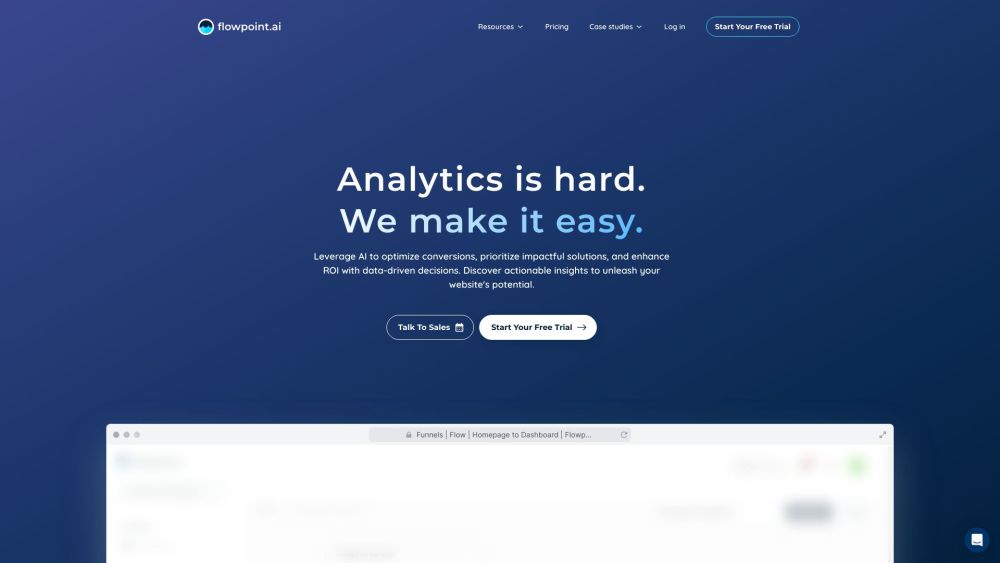
What is Flowpoint?
Flowpoint: AI Tool for Website Optimization is an innovative analytics solution powered by artificial intelligence. Its primary goal is to optimize website conversions, prioritize impactful solutions, and enhance ROI by making data-driven decisions. By leveraging its advanced algorithms, Flowpoint provides actionable insights that unlock the full potential of a website.
How to use Flowpoint?
To harness the power of Flowpoint, follow these steps: 1. Initiate the process by engaging with our sales team or starting a free trial. 2. Gain a comprehensive understanding of your customer's journey by enabling cross-domain funnel tracking. 3. Utilize funnel analytics to analyze user interactions and conversion rates, enabling you to identify areas for improvement and growth. 4. Leverage Flowpoint's AI-powered recommendations to optimize website conversion rates, enhance SEO, UX/UI, and boost content engagement. 5. Discover data-driven recommendations tailored to your specific needs, such as increasing sales or capturing new registrations. 6. Acquire valuable user insights by capturing user events, including clicks, scrolls, and time spent on different sections of your website. 7. Uncover pain points at scale within minutes, enabling you to understand your users better and improve conversions. 8. Transform data into meaningful actions by updating content or addressing UX/UI issues based on Flowpoint's insights. 9. For further in-depth insights and recommendations, take advantage of a pro-exclusive website audit conducted by our expert team.
Flowpoint's Key Features
AI-powered analytics
Cross-domain funnel tracking
Funnel analytics
AI-powered recommendations
Conversion rate optimization
User event capturing
User activity overview
Technical insights
Expert website audit
Flowpoint's Use Cases
Optimizing website conversions
Prioritizing impactful solutions
Enhancing ROI through data-driven decisions
Improving SEO, UX/UI, and content engagement
Boosting sales and registrations
Identifying user pain points
Updating content and fixing UX/UI issues
Improving website visitor journey
Optimizing content and design
Flowpoint Company
Flowpoint Company name: FLOWPOINT ANALYTICS LTD.
Flowpoint Company address: 83-86 Prince Albert Road, London, UK.
Flowpoint Sign up
Flowpoint Sign up Link: https://dashboard.flowpoint.ai/auth/register
Flowpoint Pricing
Flowpoint Pricing Link: https://flowpoint.ai/pricing/
Flowpoint Facebook
Flowpoint Facebook Link: https://www.facebook.com/flowpoint.analytics
Flowpoint Linkedin
Flowpoint Linkedin Link: https://www.linkedin.com/company/flowpoint-analytics/
Flowpoint Twitter
Flowpoint Twitter Link: https://twitter.com/flowpoint_ai
Flowpoint Instagram
Flowpoint Instagram Link: https://www.instagram.com/flowpoint.ai/
FAQ from Flowpoint
What is Flowpoint?
Flowpoint: AI Tool for Website Optimization is an advanced analytics tool powered by artificial intelligence. Its main objective is to optimize website conversions, prioritize impactful solutions, and enhance ROI through data-driven decisions. By providing actionable insights, Flowpoint unleashes the full potential of any website.
How to use Flowpoint?
Utilizing Flowpoint is straightforward. Begin by engaging with our sales team or starting a free trial. Enable cross-domain funnel tracking to gain a comprehensive understanding of your customer's journey. Utilize funnel analytics to track user interactions and conversion rates, allowing you to identify areas for improvement and growth. Take advantage of AI-powered recommendations to enhance website conversion rates, improve SEO, UX/UI, and increase content engagement. Capture user events to gain valuable insights into user behavior. Identify pain points at scale within minutes to improve conversions. Transform data into meaningful actions by addressing content and UX/UI issues. For further insights and recommendations, consider a pro-exclusive website audit conducted by our experts.
What are the key features of Flowpoint?
Flowpoint offers a range of key features designed to optimize website performance. These include AI-powered analytics, cross-domain funnel tracking, funnel analytics, AI-powered recommendations, conversion rate optimization, user event capturing, user activity overview, technical insights, and expert website audit.
What are the use cases of Flowpoint?
Flowpoint has versatile use cases, including optimizing website conversions, prioritizing impactful solutions, enhancing ROI through data-driven decisions, improving SEO, UX/UI, and content engagement, boosting sales and registrations, identifying user pain points, updating content and fixing UX/UI issues, improving website visitor journey, and optimizing content and design.